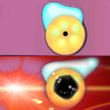Monday, 22 October 2012
Optogenetics: Neurons Controlled by Light

Among the many new techniques developed in the neurosciences in recent years, few have caused as much of a stir as optogenetics. This strange marriage between the sciences of optics and genetics allows the activity of entire populations of neurons in the brains of living animals to be controlled with a simple ray of light. Just a decade or two ago, such a technique, which is relatively non-invasive and accurate to within one millisecond, would have been unimaginable!
The key component in optogenetics is a class of proteins called light-gated channelrhodopsins, which enable algae and bacteria to detect light. These channelrhodopsins are closely related to opsins, the light-sensitive pigments in the rods and cones of the retina, which convert light into nerve impulses and thus make vision possible.
Through genetic engineering, researchers can now cause channelrhodopsins to be expressed in certain specific types of neurons. And, unlike the opsins in the human retina, which require several intermediary molecules to alter a cell’s electrical state, light-gated channelrhodopsins, as their name and the above illustration indicate, themselves provide channels by which ions can pass through the neuronal membrane. These channels can be opened or closed by a beam of light, thus altering the neuronal membrane’s permeability to ions.
Some of these channels admit ions that excite the neuron’s electrical activity, others to admit ions that inhibit it. But the beautiful thing is that the excitatory and inhibitory channels are sensitive to different wavelengths of light. Because scientists can now cause both excitatory and inhibitory channelrhodopsins to be expressed in the same population of neurons, different wavelengths of light can now be used to either excite or inhibit this population on demand.
As Gero Miesenböck, one of the main pioneers of optogenetics, puts it, any hacker will tell you that to break a code, you have to play with it. And that is exactly what optogenetics provides: the ability to “play” with neuronal activity to a degree never before possible, and then observe the effect on behaviour.
Optogenetics has already let researchers successfully use pulses of light to control specific behaviours in simple organisms—for example, the beating of the wings of fruit flies. More recent studies, in rats, have shown that light can also be used to influence more complex behaviours, such as positive reinforcement, motivation, and even conditioned fear (a form of associative learning). In animal experiments, Josh Johansen and Karl Deisseroth inserted channelrhodopsins into neurons of the lateral nucleus of the amygdala, and then successfully used a beam of light (instead of the traditional electrical shock) to generate a fear response to a stimulus that was neutral before this conditioning.
Perhaps one day, optogenetics may thus make it possible to “break the code” of how the brain functions.
![]() Neuronal light switches
Neuronal light switches
![]() Scared by the light
Scared by the light
![]() Optogenetic fMRI
Optogenetic fMRI
![]() TED TALK: Gero Miesenboeck reengineers a brain
TED TALK: Gero Miesenboeck reengineers a brain
![]() DE LA LUMIÈRE DANS LE CERVEAU
DE LA LUMIÈRE DANS LE CERVEAU
![]() LES NEURONES SOUS L’EMPRISE DE LA LUMIÈRE
LES NEURONES SOUS L’EMPRISE DE LA LUMIÈRE
Emotions and the Brain, The Senses | Comments Closed







